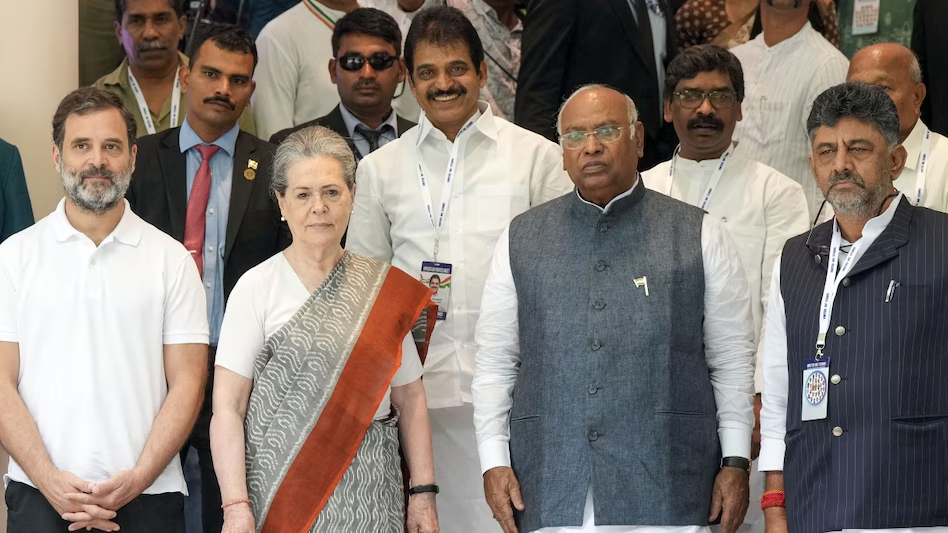As the 2024 Indian general elections approach, the political landscape is heating up with fervent exchanges between the ruling National Democratic Alliance (NDA) led by the Bharatiya Janata Party (BJP) and the newly formed opposition coalition, Indian National Developmental Inclusive Alliance (INDIA). Congress President Mallikarjun Kharge, along with other leaders of the INDIA alliance, has been vocally critical of the BJP’s bid to secure another term in power. However, their arguments often come across as impotent and misplaced for several reasons.
Lack of Unified Leadership and Vision
One of the significant weaknesses of the INDIA alliance is the absence of a clear leader and a unified vision. The alliance has brought together 26 parties, including the Indian National Congress, Trinamool Congress, Aam Aadmi Party, and others, but it struggles to present a cohesive leadership front. Despite announcements of coordination committees, there is no clear face for the coalition. This lack of a strong, singular leadership figure undermines the alliance’s credibility and makes it difficult for voters to place their trust in a nebulous opposition compared to the well-established leadership of Narendra Modi.
Internal Contradictions and Opportunism
The INDIA alliance comprises parties with significantly divergent ideologies and interests, many of which have been historical rivals. The alliance’s formation appears more as an opportunistic attempt to oust the BJP rather than a genuine effort to present a coherent alternative governance strategy. Kharge has downplayed internal differences, but such contradictions can impede effective governance and policy-making, should the alliance come to power. The electorate is wary of such alliances, recalling past instances where coalition governments have been marred by infighting and instability.
Questionable Criticisms of Economic Policies
Critics within the INDIA alliance have targeted the NDA government’s economic policies, accusing it of failing to manage inflation, unemployment, and economic disparities. While these are valid concerns, the opposition’s narrative often lacks nuance and fails to acknowledge the global economic challenges that have influenced these issues. Furthermore, their promises, such as doubling the quantity of free rations provided by the NDA, come across as populist and lack detailed planning and feasibility studies. The electorate may perceive these criticisms and promises as mere political rhetoric rather than actionable solutions.
Misjudged Nationalistic Narrative
The INDIA alliance’s decision to use the acronym ‘INDIA’ has been touted as a strategic move to pit the BJP against the nation itself. However, this can backfire by oversimplifying the political narrative and underestimating the electorate’s intelligence. By framing the contest as “INDIA vs. Modi,” the opposition risks alienating voters who may see this as a reductionist approach that overlooks the complexities of governance and national issues. Moreover, such tactics may inadvertently strengthen Modi’s image as a singular figure against whom the entire opposition must unite, potentially enhancing his stature rather than diminishing it.
Overemphasis on Alleged Misuse of Institutions
The opposition has frequently accused the Modi government of misusing federal agencies to target political rivals, claiming it undermines democracy. While there have been instances that raise questions about the impartiality of these institutions, the constant emphasis on this narrative without substantial evidence can appear as a deflection from more pressing issues. The electorate expects opposition parties to focus on constructive policy alternatives rather than perpetual grievance politics. Persistent allegations without conclusive proof can lead to voter fatigue and skepticism.
Underestimating NDA’s Political Savvy
The INDIA alliance may be underestimating the NDA’s political acumen and its robust grassroots organization. Since coming to power in 2014, the BJP has mastered the art of political communication and electioneering, successfully leveraging social media and grassroots mobilization. Despite the opposition’s efforts, the BJP remains a formidable force with a proven track record in electoral victories. The NDA’s response to the INDIA alliance’s formation was prompt, showcasing their readiness and organizational strength.
Conclusion
The INDIA alliance’s efforts to challenge the BJP-led NDA in the upcoming elections face significant hurdles. Their criticisms often appear fragmented and lack the potency needed to sway a well-informed electorate. The absence of a unified leadership, coupled with internal contradictions and a reliance on populist rhetoric, weakens their position. Additionally, framing the political contest in overly simplistic nationalistic terms and focusing excessively on allegations against the BJP without concrete evidence may not resonate well with voters looking for substantive policy alternatives and stable governance. For a more effective campaign, the INDIA alliance must address these shortcomings and present a clear, cohesive vision that goes beyond mere opposition to the BJP.






